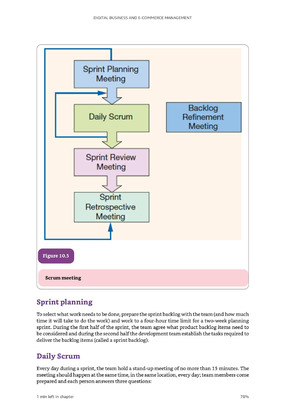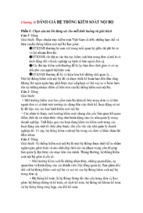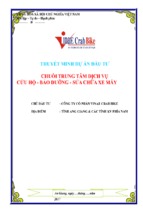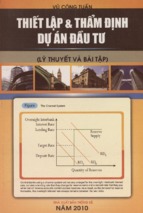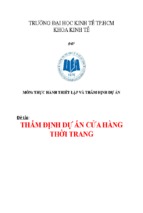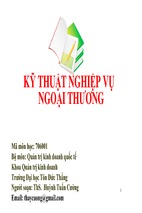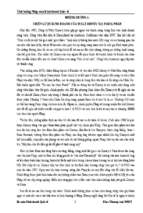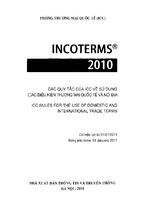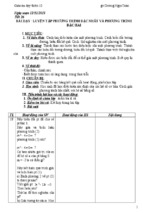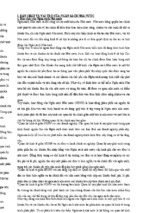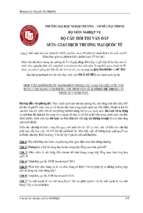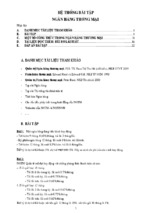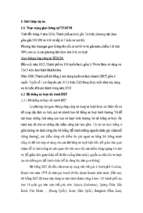Một tài liệu hay liên quan đến agile project managment.
What readers are saying about Agile Retrospectives
Esther Derby and Diana Larsen have written the definitive book on
agile retrospectives. You don’t have to be an agile team to take advantage of their book; you only have to want to improve. Follow their
advice and your teams will be more successful.
Johanna Rothman
Author, speaker and consultant, Rothman Consulting Group,
Inc.
Two of the software industry’s leading facilitators have taken their
many years of retrospective experience and distilled them into an
approachable reference for agile team leaders. For all of the self-made
facilitators out there who have been winging it, this book will provide a solid foundation to improve the effectiveness of your iteration,
release, and project retrospectives.
Dave Hoover
Lead Consultant, Agile Practices, Obtiva Corp.
This book is a wonderful compendium of ways to keep retrospectives
fresh and teams learning.
Mike Cohn
Author of Agile Estimating and Planning
This book is a must-read for all team leads, facilitators and everyone
interested in driving improvements in the ways teams reflect, learn
and function.
Sheila O’Connor, Ph.D.
Six Sigma Software Black Belt, LSI Logic, Engenio Storage
Group
Whatever you call it: retrospective, post-mortem, post-partum, postproject review. Your work can be better by stopping at regular intervals and asking, “What worked well that we don’t want to forget?
What should be done differently?” It’s almost like free consulting with
two of the best: Esther Derby and Diana Larsen. I facilitate retrospectives for a living and, believe me, I’m going to read my copy cover to
cover—more than once!
Linda Rising
Co-author of Fearless Change: Patterns for Introducing New
Ideas
Agile Retrospectives
Making Good Teams Great
Esther Derby
Diana Larsen
The Pragmatic Bookshelf
Raleigh, North Carolina Dallas, Texas
Many of the designations used by manufacturers and sellers to distinguish their products
are claimed as trademarks. Where those designations appear in this book, and The
Pragmatic Programmers, LLC was aware of a trademark claim, the designations have
been printed in initial capital letters or in all capitals. The Pragmatic Starter Kit, The
Pragmatic Programmer, Pragmatic Programming, Pragmatic Bookshelf and the linking g
device are trademarks of The Pragmatic Programmers, LLC.
Every precaution was taken in the preparation of this book. However, the publisher
assumes no responsibility for errors or omissions, or for damages that may result from
the use of information (including program listings) contained herein.
Our Pragmatic courses, workshops, and other products can help you and your team
create better software and have more fun. For more information, as well as the latest
Pragmatic titles, please visit us at
http://www.pragmaticprogrammer.com
Copyright © 2006 Esther Derby and Diana Larsen.
All rights reserved.
No part of this publication may be reproduced, stored in a retrieval system, or transmitted, in any form, or by any means, electronic, mechanical, photocopying, recording, or
otherwise, without the prior consent of the publisher.
Printed in the United States of America.
ISBN 0-9776166-4-9
Printed on acid-free paper with 85% recycled, 30% post-consumer content.
First printing, July 2006
Version: 2006-7-14
Esther:
For my husband, Jeff Lee, who has demonstrated his support
in many ways through two books now. Let’s go for three.
And for all my friends who help me with a retrospective each year
around my birthday.
Diana:
To Marny, Patty Jo and Marilyn Morningstar;
three goddesses who continue to teach me, believe in me,
and encourage me to reach for the possible,
To Abby, Andy and Willem, who bring me new ideas
from the next generation,
To Alex, who introduced me to a new way of sharing
in family and relationships,
With Love and Appreciation.
Contents
Foreword
xi
Preface
xiii
Introduction
xvi
1
2
3
4
Helping Your Team Inspect and Adapt
1.1 Set the Stage . . . . . . . . . . . . .
1.2 Gather Data . . . . . . . . . . . . . .
1.3 Generate Insights . . . . . . . . . .
1.4 Decide What to Do . . . . . . . . . .
1.5 Close the Retrospective . . . . . . .
.
.
.
.
.
.
.
.
.
.
.
.
.
.
.
.
.
.
.
.
.
.
.
.
.
.
.
.
.
.
A Retrospective Custom-Fit to Your Team
2.1 Learning About the History and Environment
2.2 Shaping the Goal for the Retrospective . . . .
2.3 Determining Duration . . . . . . . . . . . . . .
2.4 Structuring a Retrospective . . . . . . . . . . .
2.5 Selecting Activities . . . . . . . . . . . . . . . .
Leading Retrospectives
3.1 Managing Activities . . . . . . . . .
3.2 Managing Group Dynamics . . . . .
3.3 Managing Time . . . . . . . . . . . .
3.4 Managing You . . . . . . . . . . . . .
3.5 Taking Your Skills to the Next Level
Activities to Set the Stage
4.1 Check-In . . . . . . . .
4.2 Focus On/Focus Off .
4.3 ESVP . . . . . . . . . .
4.4 Working Agreements .
.
.
.
.
.
.
.
.
.
.
.
.
.
.
.
.
.
.
.
.
.
.
.
.
.
.
.
.
.
.
.
.
.
.
.
.
.
.
.
.
.
.
.
.
.
.
.
.
.
.
.
.
.
.
.
.
.
.
.
.
.
.
.
.
.
.
.
.
.
.
.
.
.
.
.
.
.
.
.
.
.
.
.
.
.
.
.
.
.
.
.
.
.
.
.
.
.
.
.
.
.
.
.
.
.
.
.
.
.
.
.
.
.
.
.
.
.
.
.
.
.
.
.
.
.
.
.
.
.
.
.
.
.
.
.
.
.
.
.
.
.
.
.
.
.
.
.
.
.
.
.
.
.
.
.
.
.
.
.
.
.
.
.
.
.
.
.
.
.
.
.
.
.
.
.
.
.
.
.
.
.
.
.
.
.
.
1
5
8
11
11
13
.
.
.
.
.
15
15
16
17
19
22
.
.
.
.
.
28
29
31
36
37
38
.
.
.
.
40
41
43
45
48
CONTENTS
5
6
7
8
9
Activities to Gather Data
5.1 Timeline . . . . . . . . .
5.2 Triple Nickels . . . . . .
5.3 Color Code Dots . . . .
5.4 Mad Sad Glad . . . . . .
5.5 Locate Strengths . . . .
5.6 Satisfaction Histogram
5.7 Team Radar . . . . . . .
5.8 Like to Like . . . . . . .
.
.
.
.
.
.
.
.
.
.
.
.
.
.
.
.
.
.
.
.
.
.
.
.
.
.
.
.
.
.
.
.
.
.
.
.
.
.
.
.
.
.
.
.
.
.
.
.
.
.
.
.
.
.
.
.
.
.
.
.
.
.
.
.
.
.
.
.
.
.
.
.
.
.
.
.
.
.
.
.
.
.
.
.
.
.
.
.
.
.
.
.
.
.
.
.
.
.
.
.
.
.
.
.
.
.
.
.
.
.
.
.
.
.
.
.
.
.
.
.
.
.
.
.
.
.
.
.
.
.
.
.
.
.
.
.
.
.
.
.
.
.
.
.
50
51
56
59
61
63
66
71
74
Activities to Generate Insights
6.1 Brainstorming/Filtering . .
6.2 Force Field Analysis . . . .
6.3 Five Whys . . . . . . . . . .
6.4 Fishbone . . . . . . . . . . .
6.5 Patterns and Shifts . . . .
6.6 Prioritize with Dots . . . . .
6.7 Report Out with Synthesis
6.8 Identify Themes . . . . . . .
6.9 Learning Matrix . . . . . .
.
.
.
.
.
.
.
.
.
.
.
.
.
.
.
.
.
.
.
.
.
.
.
.
.
.
.
.
.
.
.
.
.
.
.
.
.
.
.
.
.
.
.
.
.
.
.
.
.
.
.
.
.
.
.
.
.
.
.
.
.
.
.
.
.
.
.
.
.
.
.
.
.
.
.
.
.
.
.
.
.
.
.
.
.
.
.
.
.
.
.
.
.
.
.
.
.
.
.
.
.
.
.
.
.
.
.
.
.
.
.
.
.
.
.
.
.
.
.
.
.
.
.
.
.
.
.
.
.
.
.
.
.
.
.
.
.
.
.
.
.
.
.
.
.
.
.
.
.
.
.
.
.
77
78
81
85
87
90
92
95
97
99
Activities to Decide What to Do
7.1 Retrospective Planning Game .
7.2 SMART Goals . . . . . . . . .
7.3 Circle of Questions . . . . . . .
7.4 Short Subjects . . . . . . . . .
.
.
.
.
.
.
.
.
.
.
.
.
.
.
.
.
.
.
.
.
.
.
.
.
.
.
.
.
.
.
.
.
.
.
.
.
.
.
.
.
.
.
.
.
.
.
.
.
.
.
.
.
.
.
.
.
.
.
.
.
102
103
107
109
111
.
.
.
.
.
.
.
.
Activities to Close the Retrospective
8.1 +/Delta . . . . . . . . . . . . . . .
8.2 Appreciations . . . . . . . . . . . .
8.3 Temperature Reading . . . . . . .
8.4 Helped, Hindered, Hypothesis . .
8.5 Return on Time Invested (ROTI) .
.
.
.
.
.
.
.
.
.
.
.
.
.
.
.
.
.
.
.
.
.
.
.
.
.
113
114
117
119
122
124
Releases and Project Retrospectives
9.1 Preparing for Release and Project Retrospectives
9.2 Including Cross-Organizational Perspectives . . .
9.3 Leading Release and Project Retrospectives . . .
9.4 A Retrospective at Every Ending . . . . . . . . . .
.
.
.
.
.
.
.
.
.
.
.
.
.
.
.
.
127
128
133
135
141
.
.
.
.
.
.
.
.
.
.
.
.
.
.
.
.
.
.
.
.
.
.
.
.
.
.
.
.
.
.
.
.
.
.
.
.
.
.
.
.
ix
CONTENTS
10 Make It So
142
10.1 Provide Support . . . . . . . . . . . . . . . . . . . . . . . 143
10.2 Share Responsibility for Making Changes . . . . . . . . 145
10.3 Supporting Larger Changes . . . . . . . . . . . . . . . . . 145
A
Facilitation Supplies
149
B
Debriefing Activities
152
C
Activities Quick Reference Matrix
154
D
Resources for Learning Facilitation Skills
156
E
Bibliography
157
x
Foreword
On my birthdays, I look back and reflect on my life. How have things
gone? Where did I think I would be thirty years ago, ten years ago, one
year ago? Where am I now? How could I do things better, and what
things that I rue should I just resolve so I can get past them? Am I the
type of person I hoped to be, and is the impact I have on others what
I would hope for? If not, what might I do differently in the upcoming
year(s)? Have I used the strength and intelligence that I have wisely?
This is my retrospective. I look back and assess. I consider. Taking
everything into account, I try to set a better course for the upcoming
year. I’m really glad that nobody is keeping score, even me, because I
don’t know how well I’m doing overall. I guess it depends on philosophies that keep changing and on circumstances that bring more variability than I ever expected. Who could have predicted what my children would be like?
Maybe if I had clearer goals and more frequent birthdays, the retrospectives would work better. I’ll bet that if I had Esther and Diana at
my more frequent birthdays, things would work out better. An outside
facilitator with techniques like they spell out in this book would provide
new insights and help formulate more concrete next steps.
I’ve been using iterative, incremental (a.k.a. Agile) processes formally
for eleven years; my drink of choice is called Scrum. The goals are
very clear in Scrum. They are established for a project and then reset
for every iteration. Since these iterations are every thirty days, there
isn’t a lot of wandering. Since the domain is building software, not
just life in general, it is also easier to tell whether progress is in the
right direction or needs adjusting. Because Scrum is a team activity,
the group reflection is particularly helpful. Everyone chips in, and the
surprises are manifold.
F OREWORD
Edward Yourdon described the long, terrible progress through a project
in Death March (Prentice Hall, 1997). A problem with these projects
is that there are no birthdays and no regular points for reflection and
readjustment.
The natural rhythm of the iterative delivery of software in Agile projects
provides such a break point. These are chances for the team to improve
what it is doing and how they feel about what they are doing. What an
opportunity. Read Esther and Diana’s book and see how it works.
Ken Schwaber
Scrum Author and Evangelist
Scrum Alliance
xii
Preface
When we say retrospective, here’s what we have in mind: a special
meeting where the team gathers after completing an increment of work
to inspect and adapt their methods and teamwork. Retrospectives
enable whole-team learning, act as catalysts for change, and generate action. Retrospectives go beyond checklist project audits or perfunctory project closeouts. And, in contrast to traditional postmortems
or project reviews, retrospectives focus not only on the development
process, but on the team and team issues. And team issues are as
challenging as technical issues—if not more so.
We have been leading retrospectives and teaching others to lead retrospectives for a combined twenty years. In fact, in 2003, we were
bestowed with the title Retrospective Goddesses at the annual Retrospective Facilitators Gathering in Baden, Austria. It’s not every day
you get to read a book written by a pair of goddesses! Although we
don’t really claim divinity, we do know lots about helping teams learn
together in retrospectives.
We’ve talked to people who claim that retrospectives are a waste of
time. When we probe for details, the process they describe doesn’t
resemble what we would call a retrospective. However, when people
follow a process similar to what we describe in this book, we’ve seen
solid, bottom-line results.
Our clients and colleagues tell us that they see benefits from retrospectives, too. Here’s some of what we’ve seen and heard. In each case the
team identified improvements during their retrospective and applied
new practices in the next iteration.
Improved Productivity A team in California reduced rework at the
end of their next release by improving their unit testing. They added
more tests and tested more frequently. Because they were finding
errors earlier, they didn’t have to scramble at the end of the release.
P REFACE
Improved Capability A team in Florida used their retrospective to
devise a solution to a long-standing problem. Only one person on the
team knew how to integrate client data with the corporate database.
The team established a pairing schedule that enabled other team members to learn about the database and eliminated the bottleneck.
Improved Quality A team in Minnesota observed a clear connection
between lack of customer contact during their iterations and missed
requirements. They increased customer involvement during subsequent iterations to reduce misunderstandings and rework on features.
As collaboration with the customer increased, the team spent less time
re-hashing and more time preventing defects and refactoring.
Increased Capacity A team in New York examined how they prioritized features and moved from yearly to quarterly releases by focusing
on delivering smaller high-value feature sets.
Along with bottom line benefits, retrospectives have a way of increasing
empowerment and enjoyment for teams.
After performing iteration retrospectives for a year, a team in London reported that retrospectives had changed their lives for the better.
Another team called in a social worker when they faced an especially
tough problem. After observing the team, the social worker pointed out
that the team had better skills for navigating conflict than most of the
professional social workers he knew [Mac03]. The team knew how to
have the uncomfortable—but necessary—conversations to resolve disagreements before they escalated into conflict or resentment.
We can’t predict the results you’ll achieve, but the evidence shows that
retrospectives can improve teamwork, methods, work satisfaction, and
results.
We want to thank our reviewers for their invaluable help. This book
wouldn’t be what it is without them: Tim Bacon, Raj Balasubramanian,
Nicole Belilos, Johannes Brodwall, Brandon Campbell, Mike Cohn, Rachel Davies, Dale Emery, Marc Evers, Pat Eyler, Caton Gates, David
Greenfield, Daniel Grenner, Elisabeth Hendrickson, Darcy Hitchcock,
Dave Hoover, Stephen Jenkins, Bil Kleb, Willem Larsen, Anthony Lauder, Sunil Menda, Sheila O’Connor, David Pickett, Wes Reisz, Linda
Rising, Johanna Rothman, Matt Secoske, Guerry Semones, Dave W.
Smith, Michael Stok, and Bas Vodde.
xiv
P REFACE
We would be remiss if we didn’t thank Norm Kerth. Norm is the elder
statesman of retrospectives and has worked to make retrospectives
common practice. We’ve both known Norm for years, and in fact, he’s
the one who introduced us to each other. We found common ground
with Norm in work that each of us was doing independently and, out of
that common ground, started the Retrospective Facilitators Gathering
in 2001.
We want to thank the members of the Retrospective Facilitators Gathering. Each year we meet with people who are doing amazing work
with retrospectives. At the first gathering in Oregon, four countries
were represented (Austria, Denmark, the Netherlands and the USA).
The 2006 gathering, held in Germany, brought together people from
eleven countries. The people of the gathering are generous with their
insights, experiences, and activities.
Finally, we want to thank Andy Hunt, Dave Thomas, and Steve Peter at
the Pragmatic Bookshelf. We couldn’t have done it without you.
xv
Introduction
Suppose you are a member of a software development team. You’re
doing good work, but not great work. You’re starting to see signs of
interpersonal friction on the team, and some people you would like to
retain on the team are dusting off their résumés. You know you need to
adapt your practices and ease the interpersonal tension before things
get worse. You want to introduce retrospectives to your team.
Maybe you are a team lead, and you’ve heard about retrospectives but
have never tried one. You’ve heard retrospectives can help teams perform better, but you’re not sure where to start.
Maybe you’ve been holding retrospectives for months, and your team
isn’t coming up with any new ideas. You need a way revitalize your
retrospectives so the team doesn’t lose the gains they’ve made.
Whatever the reason you’ve picked up this book, we assume you think
retrospectives might help your team. Whether you’re a coach, a team
member, or a project manager and whether you’re expected to lead
retrospectives after every iteration or are initiating retrospectives for
the first time, you’ll find ideas and techniques that you can apply to
your situation.
Our main focus in this book is short retrospectives—retrospectives that
occur after one week to one month of work. Whether you are using Agile
methods or more traditional incremental or iterative development, your
team has an opportunity to reflect at the end of every increment and
identify changes and improvements that will increase the quality of the
product and the work life of team members.
Retrospectives are a natural fit in an Agile work environment—Scrum
and Crystal explicitly include “inspect and adapt” cycles for the methods and teamwork along with mechanisms to examine and improve the
product. While continuous builds, automated unit tests, and frequent
I NTRODUCTION
demonstrations of working code are all ways to focus attention on the
product and allow the team to make adjustments, retrospectives focus
attention on how the team does their work and interacts.
Retrospectives are also a natural fit in a team environment—where
membership in the team is less than ten and the work is interdependent. Retrospectives help people improve practices, handle issues, and
surface obstacles on a regular basis.
Iteration retrospectives focus on real problems that affect teams. During retrospectives, teams discover real solutions that they can implement without waiting for management’s permission. Since experiments
and changes are chosen, not imposed from above, people are more
invested in their success.
When we started leading retrospectives more than a decade ago, most
retrospectives looked at whole projects that had run for a year or more.
In the past ten years, there has been a shift. More and more teams are
working in shorter iterations and releasing software more frequently.
These teams no longer wait until the end of a long project to inspect
and adapt. They look for ways to improve at the end of every iteration.
Team coaches, team leads, and team members now lead their own retrospectives.
Even if your team isn’t using Agile methods, you can adapt the advice
in this book to inspect and adapt your processes and teamwork before
the end of a project: hold a retrospective every month or so or at project
milestones.
You may need to convince your managers that this is a good use of your
time and company dollars. A growing body of data—both financial and
empirical—shows that consistent retrospectives result in real savings
and improvements.
In this book, we’ll introduce a structure for retrospectives and walk
through the process of planning, designing, and leading a retrospective.
We’ll supply activities and guidance on how to use them, and we’ll share
stories from real retrospectives.
We’ve also included a chapter on the role of the retrospective leader. We
believe that most people can lead retrospectives with confidence and
competence—and help the team achieve results—with a good structure
and the right tools.
xvii
I NTRODUCTION
And, we’ve included examples of how you can adjust the basic retrospective structure for a three-month release or a yearlong project—and
anything in between. Even if the team disbands after the release or
project, the organization can learn from a retrospective, and individuals will take the learning with them.
xviii
Chapter 1
Helping Your Team Inspect and
Adapt
Retrospectives help teams—even great ones—keep improving. In this
chapter, we’ll start with an example of an hour-long iteration retrospective. We’ll watch what the retrospective leader does, and then we’ll
analyze the example so you can apply the process to your retrospectives.
Let’s peek in on a team who writes financial software as they hold their
retrospective at the end of a two-week iteration. This team rotates leadership of the retrospective, and this week, it’s Dana’s turn to lead.
After all the team members are seated in a semicircle facing a large
white board with several posters at one end, Dana starts the retrospective.
“Here we are again, taking time to examine our work in the last iteration. We have an hour blocked to focus on our teamwork and methods.
It’s 4 PM now; we should be finished by 5. This time, we’re going to
focus on our development processes, because we’ve noticed the number of defects is increasing.”
“Before we look at the data, let’s do a quick check-in: in a word or two,
what’s going on for you as we start this retrospective?”
Each of the six team members gave a short response. “I’m puzzled,”
said the first.
C HAPTER 1. H ELPING Y OUR T EAM I NSPECT
AND
“Curious,” said the second.
“Bummed about the defects,” answered the third.
“Hey, that’s more than a word or two!” said the first team member and
gave the wordy team member a poke in the arm.
“OK. Bummed,” he corrected.
The last two gave their responses, and Dana moved on.
“Do we need any amendments to our usual working agreements for this
meeting?” Dana asked, gesturing to the working agreements posted on
the wall. After all agreed the working agreements were sufficient, Dana
outlined the process for the meeting.
“First we’ll look at our data and then brainstorm and cluster possible
causes. After that, we’ll generate some ideas to approach the problem
in our next iteration, choose one, and design an experiment. Sound
OK?”
When all agreed, Dana moved to the next step.
“Let’s look at our defect data,” Dana said, pointing to a large chart
that showed each feature they’d worked on and the number of defects
they’d found in their own testing. “What was going on here?” she asked.
“Give me a read on what was going on as you worked on each of these
features.” She handed out small, colored sticky notes. “Let’s look at
what was going on during the iteration—post the events you remember.
Then put an orange sticky note where there was frustration.”
“Hmm,” a team member mused as she put the last orange sticky note
on the wall. “I’m surprised that the frustration isn’t clustered with the
defects. I wonder what that’s about.”
“Let’s see whether we can answer that. Take five minutes to write down
everything we know and then see what patterns we can discern.” Dana
handed out larger sticky notes and markers.
One team member wrote furiously. Another stared at the chart for a
minute and then started jotting down notes. Two others talked quietly
and compared ideas as they started writing.
At the end of five minutes, team members walked to the white board
and stuck their sticky notes on it.
“Which of these seem like they might have a similar cause?” Dana
asked. Team members moved the sticky notes around, putting two or
A DAPT
2
- Xem thêm -


